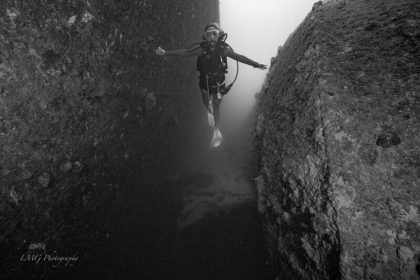On Friday, April 7, 2017, the Guam Visitors Bureau (GVB) will commemorate the 100th Anniversary of the scuttling of the SMS Cormoran II. The ship has a unique story that includes how it came to rest at the bottom of Guam’s harbor on April 7, 1917, being part of one of the world’s most unique dive spots, and its place in US history as the location of the country’s first shot fired in World War I. The story of the Cormoran also includes how she became a memory until a young diver named Herbert T. Ward gave her new life.
A civilian employee of the Navy, Herbert Ward first came to Guam in 1953. This was Ward’s second venture with the US Navy, having lied his way to enlisting at age 16, where he discovered his love of the open sea. Now living in Guam, Ward took every opportunity to dive and explore Guam’s underwater world. One of his favorite dives was to the many shipwrecks that dotted Guam’s reefs and resided in Apra Harbor.

Swimming inside the SMS Cormoran at 90 feet. This passageway inside the wreck is one level below the deck of the ship. As the Cormoran came to rest on the bottom, she settled on her starboard side. The slight tilt to this picture gives you a sense of the actual perspective as you swim through the ship.
In 1965, Ward was contacted by a friend coming to Guam for a vacation, who expressed an interest in diving something new. Ward went to work researching the many possibilities and eliminating them as being over visited, picked over, and left with nothing unique to offer. He finally decided to try and find the elusive SMS Cormoran in Apra Harbor.
When the Cormoran initially sank in 1917, her resting place was marked with buoys by the US military. After many years, the ship was no longer marked and while local divers knew her location, they were secretive about it. Ward poured over old military photos of Apra Harbor and was able to pinpoint a location where he felt sure the Cormoran lie. He knew there were local divers who were aware of the ship’s location, but they would not easily share the information.
Working with a diving friend to photograph living golden cowry shells, he met another diver who knew the site of the Cormoran. His new friend offered to take him to the ship. When they arrived, Ward was happy to find his calculations for her position were correct.
Ward’s first dive to the SMS Cormoran found the vessel in much better shape than he’d anticipated. Fearing she would be mostly disintegrated, the Cormoran was mostly intact with smokestacks, porthole glass, and steel side doors still intact. Diving with a single tank, Ward was unable to spend as much time as he wanted on the wreck, but he returned with his new friend the following day. As his companion began retrieving treasures from the Cormoran, Ward became more and more enamored of the vessel, patiently waiting for the moment he could begin exploring her on his own.
Ward began diving the Cormoran daily, bring up artifacts that he carefully removed from the ship. The interior of the vessel had filled with a thick, mud-like silt that made excavating items difficult, especially at the ship’s lower levels, and always affected visibility. In addition to artifact retrieval, Ward also began spending time researching the SMS Cormoran at local libraries. He found a lot of conflicting information that he was able to correct working with some of the Cormoran’s surviving crew members.
During the course of his many dives over the years, Ward was able to retrieve an amazing collection of artifacts. In his book, Flight of the Cormoran, he describes his home as becoming a museum for the SMS Cormoran. He dove the wreck as often as he could and though tragic, it is somehow fitting that Herbert T. Ward died onboard the ship he loved so well. He passed in 1975 while diving the Cormoran. His daughter believes in spite of easily being the most knowledgeable diver of this shipwreck, Ward became so engrossed in his exploration that he ran out of air and couldn’t make it to the top. His remains were cremated and his ashes released on the SMS Cormoran.
PHOTO: The SMS Cormoran as she rests in the sand at 120 feet in Apra Harbor, Guam. On April 7, 1917 Captain Zuckschwerdt ordered the crew to scuttle the ship, instead of surrendering the SMS Cormoran to the United States.








Leave a Comment